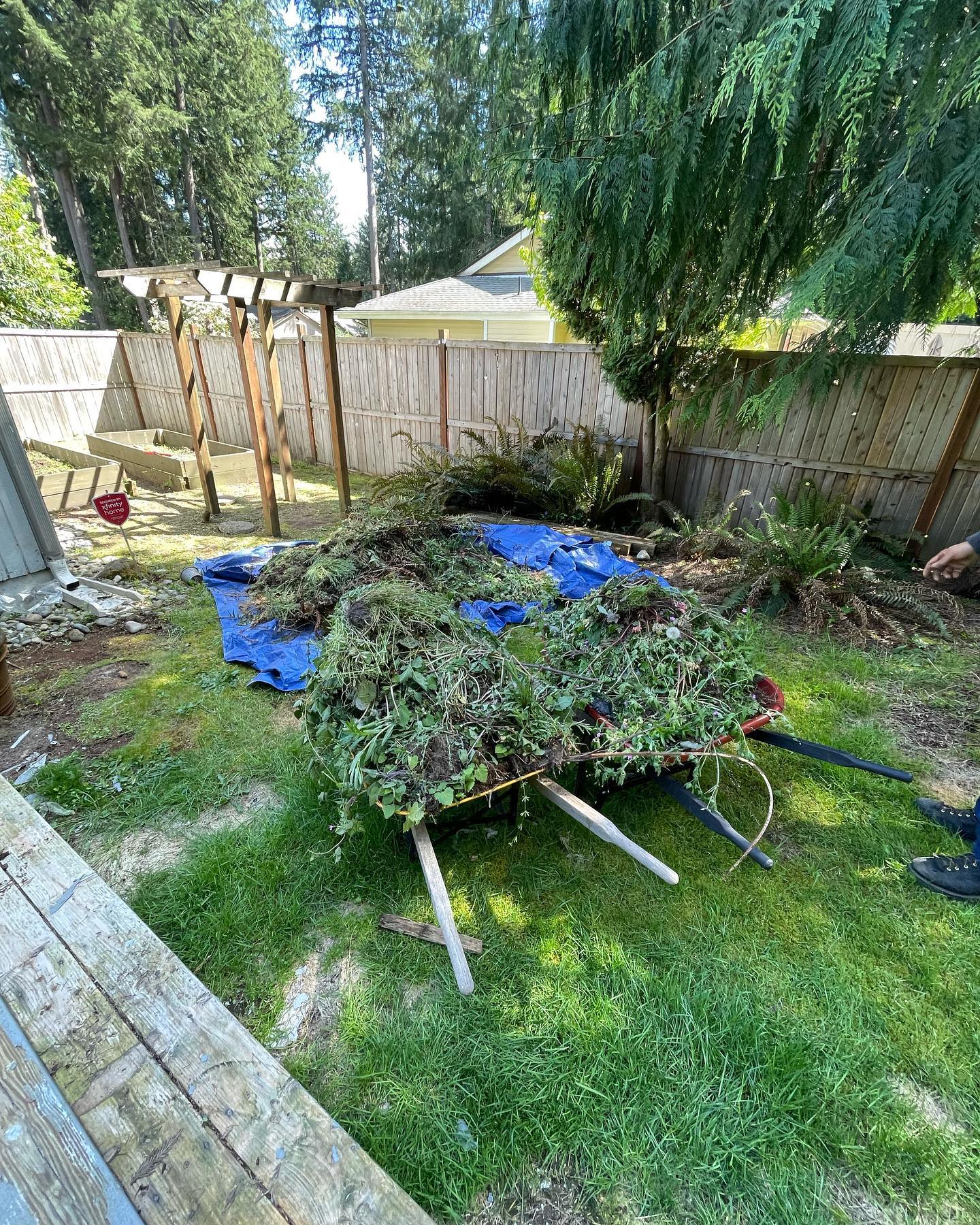Your work on your lawn, whether everyday clean-up or in-depth lawn maintenance, produces waste. Disposing of yard waste may seem easy, but not knowing how to do it properly can easily become stressful.
Yard clean-up is crucial if you want to have a clutter-free home. So, after completing your maintenance work, like mowing, ensure you have a concrete plan for getting rid of the waste. Fortunately, as you will see in this post, there are many yard waste removal methods to choose from.
Keep reading for comprehensive details on how to get rid of yard waste.
What Is Yard Waste?
Yard waste refers to organic materials, including various plant-based materials generated from maintaining gardens, outdoor spaces, or yards. Yard waste can be categorized into several common types:
- Grass Clippings produced from lawn mowing form a significant portion of yard waste.
- Leaves- Fallen leaves from trees and shrubs during the autumn.
- Branches and Twigs-Trimmings, pruning, and small branches from trees and shrubs are typically generated when maintaining the shape and health of plants in the yard.
- Garden Debris- This includes plant trimmings, spent flowers, weeds, and other organic waste from vegetable gardens, flower beds, and other cultivated areas.
- Hedge Clippings comprise trimmings from hedges and shrubs.
Note
Some additional organic materials, such as straw, hay, and wood chips, can also make up yard waste.
Read More:
Why Shouldn’t You Put Yard Waste In The Garbage?
You should not dispose of yard waste in garbage bins for various reasons. These are:
1. It Takes Up Beneficial Landfill Space
Since yard waste is biodegradable, it breaks down naturally over time. Therefore, yard waste ends up taking up valuable landfill space that non-biodegradable waste could use if dumped in landfills along with regular garbage.
Diverting yard waste from landfills helps extend the lifespan of these facilities and reduces the need for new ones.
2) Methane Production
Organic materials, such as yard waste, produce methane gas when decomposing in anaerobic (oxygen-deprived) conditions. This gas is a potent greenhouse gas that contributes to climate change.
Sending yard waste to landfills makes it decompose without sufficient oxygen, generating methane. Therefore, proper yard waste disposal, whether through composting or recycling, helps minimize methane emissions.
3) Resource Conservation
Yard waste contains valuable nutrients and organic matter that can be recycled and used to enrich soil and support plant growth. So, throwing away these wastes causes the wastage of these resources. For this reason, adopting ways to recycle yard waste back into the environment benefits gardens, landscapes, and agricultural areas.
4) Environmental Impact
Mixing yard waste with regular garbage can lead to additional environmental concerns. For example, when yard waste decomposes in a landfill, it can produce leachate- a liquid containing harmful substances and pollutants. Leachate has the potential to contaminate soil and water sources if not appropriately managed.
9 Ways to Dispose of Yard Waste
Make lawn maintenance easier by choosing an effective yard waste disposal method. Here are your options.
1. Composting
Recycle your yard waste by creating a compost pile or use a compost bin to decompose it naturally. This excellent recycling method gives you a proper way to get rid of your grass clippings, leaves, small branches, and other organic materials.
After some time, the organic materials decompose into nutrient-rich compost, thus improving soil quality in gardens and landscaping. It lowers the need for synthetic fertilizers, soil conditioners, and pesticides.
2. Mulching
Mulching involves finely chopping leaves, grass clippings, and small branches, then spreading them around your garden beds or beneath trees and shrubs. If you have a mulching lawnmower or a chipper/shredder, you can process yard waste on-site and use it as mulch.
Also, a wood chipper which you can rent from a hardware store, can help turn large stumps or twigs into mulch.
Mulch helps retain moisture, suppress weed growth, moderate soil temperature, prevent erosion, and boost soil health. However, it can shelter pests and even cause moisture and fungal issues.
3. Municipal Collection Programs
Many cities and municipalities provide separate collection programs for yard waste, such as curbside pickup or designated drop-off locations for its residents. Check with the local authorities responsible for waste management to discover the specific guidelines and collection schedules if you are considering this approach.
4. Yard Waste Recycling Centers
Some areas have dedicated yard waste recycling centers or facilities where you can bring your yard waste for proper disposal or recycling. These facilities typically accept grass clippings, leaves, branches, and other organic debris. The yard waste is then processed into mulch, compost, or other valuable products.
5. Local Garden Centers or Farms
Some local garden centers or farms may accept yard waste for composting or other purposes. Contact them to check whether they run any programs that receive yard waste.
6. Community or Neighborhood Composting
Some communities have community or neighborhood composting initiatives. These programs allow residents to contribute their yard waste to a shared composting facility or composting bins. It’s a collaborative effort to recycle organic materials and produce compost for community use.
If your community has one, you can dispose of your yard waste through such a program.
7. Donate To A Friend or Neighbor
You can also donate your yard waste to a neighbor or friend who can put it to good use. They could use your yard waste for compost, mulch, and gardening or landscaping projects.
If your neighbor or friend is working on a gardening or landscaping project, they may use your waste as a resource. For example, they might use branches or twigs to create decorative or functional purposes such as natural fences and garden stakes.
However, before donating your yard waste, communicate with your neighbor or friend to ensure they are interested in receiving it and have a use for it. Additionally, consider the condition and quality of the yard waste you’re offering, ensuring it is free from pests, diseases, or harmful substances.
Donating yard waste to a neighbor or friend not only helps them in their gardening or landscaping endeavors but also promotes community engagement and sustainability by reusing resources locally. Furthermore, it is a cost-effective, convenient yard waste removal method.
8. Grasscycling
Grasscycling is the practice of leaving grass clippings on the lawn after mowing rather than collecting and disposing of them. It involves allowing the clippings to remain on the grass and naturally decompose.
Grasscycling is most effective during the grasses’ growing seasons, usually in spring and summer. However, collecting and disposing of clippings during periods of excessive growth or when the grass is too long may be necessary to avoid smothering the lawn.
You can promote a healthier lawn, reduce waste, save time, and contribute to sustainable lawn care practices by practising grasscycling. Below are the advantages of Disposing of yard waste this way.
a) Nutrient Recycling
Grass clippings are rich in nutrients such as phosphorus, nitrogen, and potassium. Therefore, leaving them on the lawn recycles the nutrients into the soil. As the clippings decompose, the nutrients are released, providing natural fertilization for the grass.
b) Soil Health and Moisture Retention
When left on the lawn, grass clippings also act as a natural mulch layer. They help retain moisture in the soil, reducing water evaporation and promoting healthier, more resilient grass roots. The clippings also add organic matter to the earth, improving its structure and nutrient-holding capacity.
c) Time and Effort Savings
By grasscycling, you do not have to collect and dispose of clippings after cutting the grass. This saves time, reduces yard waste volume, and eliminates the hassle of bagging or raking clippings.
Tips for Effectively Grasscycling
To effectively practice grasscycling, consider the following tips:
i) Mow Regularly
Maintain a regular mowing schedule, cutting only about one-third of the grass blade’s height at a time. Removing excessive amounts of grass at once can lead to clumping and uneven distribution of clippings.
ii) Invest In A Mulching Mower
Mulching mowers have special blades that finely chop the grass clippings and disperse them evenly on the lawn. These mowers help prevent clumps and promote faster decomposition. Therefore, buy a mulching mower if grasscycling is your preferred yard waste removal method.
iii) Dry Conditions
Mow when the grass is dry to prevent clumping. Wet grass clippings tend to stick together and can smother the grass underneath.
9. Burn Your Yard Waste
Burning is also an effective yard waste removal method as it requires minimal effort and is cost-effective. However, it would be best to consider the local regulations, environmental conditions, and fire safety guidelines to avoid breaking the rules.
Check with your local fire department, municipal authorities, or environmental agencies to understand the rules and regulations governing yard waste burning in your area. They can provide information on any permits required, specific restrictions, or designated burn days.
Conclusion
Unless you intentionally want to leave grass clippings in your yard after mowing, proper disposal is fundamental for your lawn’s appearance, health, and overall environmental protection.
It’s in your best interests to be proactive regarding yard waste management because it will keep it from piling, making discarding overwhelming.

Hey there, I’m Derek Schew, a writer for Lawnholic.com, where we cover everything and anything related to lawns. As someone who’s spent countless hours tending to my own lawn, I’m passionate about sharing my knowledge and helping others achieve the perfect yard. From lawn care tips to product reviews, I’m committed to providing our readers with the most accurate and up-to-date information available. So whether you’re a seasoned lawn enthusiast or just getting started, I invite you to join our community and discover the joys of a lush, green lawn.

